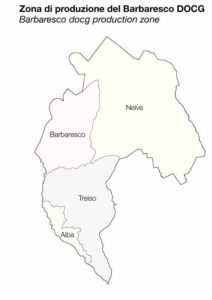The Barbaresco zone, officially delimited in 1966 with the recognition of Denominazione di Origine Controllata (DOC) and, in 1980, with the introduction of Denominazione di Origine Controllata e Garantita (DOCG), takes in 4 different communes. These are Barbaresco, Neive and Treiso, which lie entirely within the appellation boundaries, and Alba, which lie within it in part, more precisely with the small area of San Rocco Seno d’Elvio
In this section I have dedicated to each of them a short introduction describing the main features of the communal territory and the MGA subdivisions, leaving further details to be analyzed in depth under each single MGA entry. This for two reasons: 1) the study of a territory must, in my opinion, proceed step by step; 2) with more detailed information, the profiles of many communes would have become too extensive to be consulted on the web.
To accomplish this task I have often had to resort to images that cover a much larger portion of the territory than those that appear with the MGA entries. This means that in some cases the boundaries may not be perfectly accurate, but still close enough for our purposes. In general, in the introductory images that illustrate the various sectors and slopes within the communal territory, I have highlighted all of the vineyards that lie within the commune, while in the detailed images of the individual sectors or slopes I have usually highlighted only the vineyards that fall within the various MGAs concerned.

It should also be noted that of the three main communes in the denomination, Neive is the largest, followed by Treiso and Barbaresco.
The most intensely planted with vines is Barbaresco, which can also boast the largest presence of nebbiolo.
For your reference, here follows a summary of the various details of the production regulations for Barbaresco DOCG.
Grape variety: 100% Nebbiolo.
Maximum production per hectare: 8 metric tons or 54,4 hectoliters or 7,253 bottles of wine.
Minimum legal ageing: 38 months from the 1st of November of the year after the harvest, 18 of which in wood barrels. The term “Riserva” can be used on the label when the wine has been cellared for 5 years, calculated once again from the 1st of November of the year after the harvest.
Minimum alcohol content: 13% Vol.
Minimum total acidity: 4.5 grams per liter.
Minimum dry extract: 22 grams per liter.
On the label – in addition to the appellation name Barbaresco and, in certain cases, the specification of “Riserva” status – can appear:
Menzione Geografica Aggiuntiva (MGA or “cru”)
(e.g. Barbaresco Asili)
Vigna (“vineyard”), but only when used along with the name of a MGA
(e.g. Barbaresco Albesani Vigna Borgese)
In this last case, the addition of the word “Vigna” is not necessarily an indication of superior quality compared to that of a Barbaresco which carries solely the MGA indication, and this despite the fact that the use of the word “Vigna” obliges the producer to reduce yields by 10%, from 8 to 7.2 tons per hectare (from 3.2 to 2.88 tons per acre).